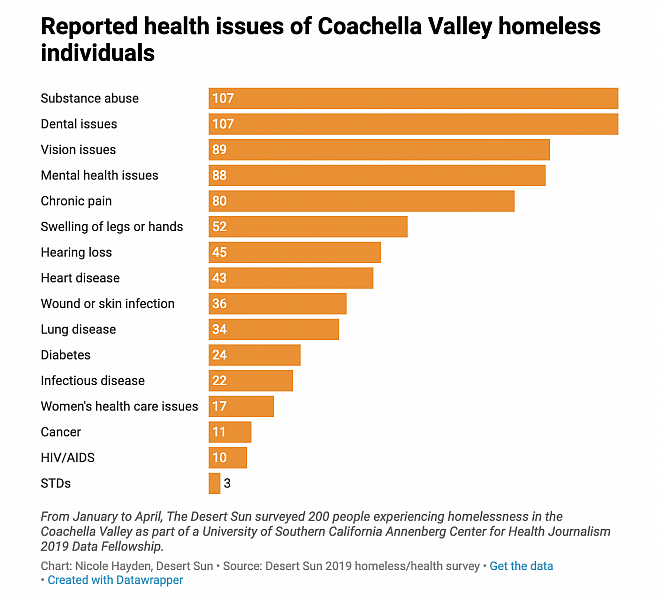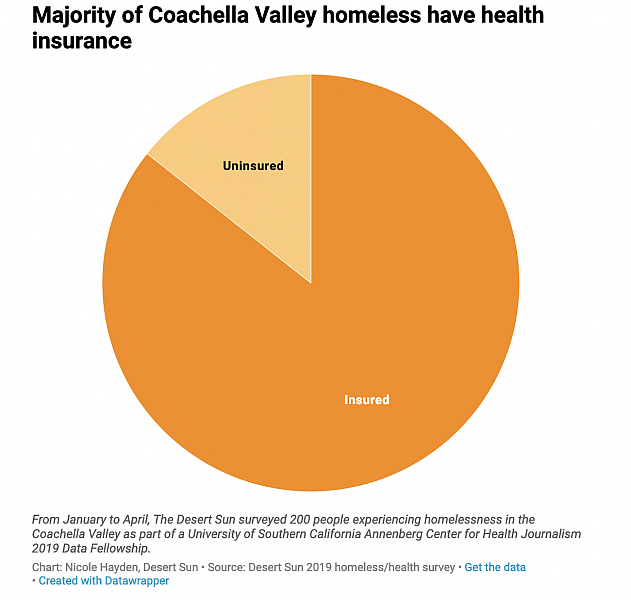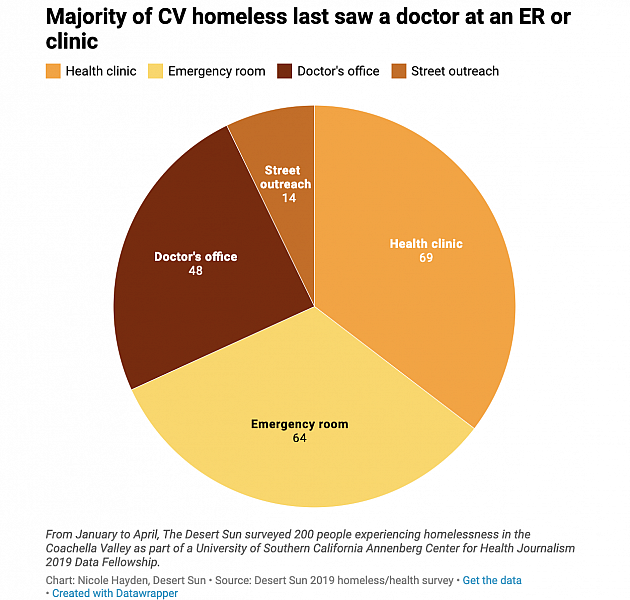The Desert Sun interviewed 200 homeless individuals about health care. Here's what we found
This story was produced as part of a larger project led by Nicole Hayden, a participant in the 2018 Data Fellowship.
Other stories in this series include:
You asked, we answered: How can people help those who are homeless in the Coachella Valley?
Homeless in the Coachella Valley: Join us for a special evening of storytelling, solutions
You asked, we answered: How is money being spent on homeless services in Riverside County?
You asked, we answered: Why did Roy’s Resource center close in Palm Springs?

(Photo by The Desert Sun)
From January to April, The Desert Sun surveyed 200 people experiencing homelessness in the Coachella Valley as part of a University of Southern California Annenberg Center for Health Journalism 2018 Data Fellowship. The survey focused on health needs and access to health care for those who are homeless.
The in-person survey included 23 questions and was conducted by reporters visiting emergency shelters, homeless encampments and walking the streets of the Coachella Valley to find people experiencing homelessness who agreed to be interviewed. The data-collection team verbally asked each person the questions — the survey typically took five to 20 minutes per person to complete.
According to the 2018 point-in-time count, 438 people were experiencing homelessness in the Coachella Valley during a single night in January of that year. The overall survey of 200 people experiencing homelessness in the Coachella Valley carries a margin of error of plus or minus 5.1 percent points. The margin of error increases for responses from subsets of the larger group.
The first story of the project focused on substance abuse and mental health needs in the community. While wary of reenforcing the stereotypical connection of homelessness and drug abuse — because that is not representative of everyone — The Desert Sun chose that topic to look at in depth first because the data showed that drug and behavioral health treatments are among the greatest needs in the community with the least available services in the Coachella Valley.
Riverside County has 26 different behavioral health programs positioned throughout the county with outreach teams that focus on homelessness and housing, said Tom Petreson, Riverside University Health System Behavioral Health spokesman. The county has substance abuse clinics in Desert Hot Springs, Palm Desert, Indio and Cathedral City. All offer crisis intervention, medication services, case management, recovery management and dual-diagnosis treatment.
But those providing weekly medical care on the streets in the Coachella Valley say more behavioral health outreach workers are needed that are able to canvas the streets on a more regular basis.
Here’s a look at other information we learned through our survey.

Substance abuse and mental health are among the top-reported issues of people experiencing homelessness in the Coachella Valley, at 55% and 44%, respectively.
Additionally, 55% of those surveyed reported that dental work is their greatest need. Respondents reported that they found it challenging to get a job if they had missing or rotted teeth. While many reported this as a need, there are several under-utilized providers in the Coachella Valley who offer free or reduced-cost dental work, from minor things like fillings to larger procedures like denture work. The Desert Sun found people aren’t aware that these services exist.
Dental providers include the SAGE Initiative in Indio, the Coachella Valley Volunteers in Medicine clinic in Indio and the Desert AIDS Project in Palm Springs, which is a Federally Qualified Health Center that provides care for everyone, not just HIV patients.
Of those surveyed, 86% reported they had insurance. This aligns with the state’s push to have medical providers sign patients up for health insurance if they arrived at the clinic or emergency room without any. Of those without insurance, less than 30% hadn’t seen a medical provider in more than a year.

According to the survey data, 75% of those staying in emergency shelters or transitional housing reported they had seen a doctor within the past three months, which is likely due to the fact that the Health to Hope Clinic is located on the campus of both the Coachella Valley Rescue Mission and Martha's Village and Kitchen. Of those who were living unsheltered, 30% reported they hadn't seen a doctor in the past year and 45% of those respondents said the last time they saw a doctor was in an emergency room.
In addition, 67% of east valley respondents said they received medical care in the past three months, while 57% of west valley respondents did. Those in the west valley were 3.5 times more likely to access that care at an emergency room, likely because the west valley doesn't have services such as the Health to Hope Clinics or the Coachella Valley Volunteers in Medicine.
Sixty-nine percent reported they don’t see the same doctor regularly.
The Desert AIDS Project in Palm Springs is a Federally Qualified Health Center similar to the Health to Hope Clinics in the east valley; however, many of those surveyed said they didn't realize they could access health care at the Palm Springs clinic.
"Under the FQHC model, folks are provided primary health care in underserved areas," said Jack Bunting, Desert AIDS Project spokesman. "And that does include our homeless community members."
The clinic also has staff members who drive to locate clients who are homeless if they have missed vital appointments. DAP is currently working to double their capacity in order to serve more patients.
As for other needs, 40% of those surveyed reported they suffered from chronic pain, many related to prior accidents or surgeries; 26% said they experienced constant swelling of their hands or legs; 45% said they had vision issues and needed glasses; 23% reported hearing loss; 22% reported heart disease, such as high blood pressure; and 18% reported having wound and skin infections.
Of those surveyed, 5% reported being HIV-positive and 11% reported having other infectious diseases, such as hepatitis C. Of those who reported being HIV-positive, 70% were living unsheltered in Palm Springs, which is where the Desert AIDS Project is located. (People tend to cluster around providers of needed services.)
Overall, 53% said they needed greater access to treatment, including behavioral health specialists and gynecologists; 43% said they needed follow-up treatment that was easier to access; and 15% said they need access to vaccines.

While 65% of people said it is easy to access needed medication, many anecdotally said their challenge is having a safe place to store their medication so it doesn’t get stolen, which is common.
Demographically, 55% of those we interviewed are from the Coachella Valley; 73% from the Inland Empire overall; 74% were men; 66% were white, 45% were Hispanic; the average age was 46; and fewer than 4% were veterans. Riverside County has made housing veterans a top priority.
Of those surveyed, about 54% reported they received care from a street outreach team or a local reduced-cost clinic.
Among those respondents, 80% rated the care they received as "good" or "great." Of those who hadn't been in contact with the street medicine team before, 70% said they weren't knowledgeable about how to access the team or believed they lived outside of the service area.
Respondents were given a chance to add comments about what they thought their greatest health needs were, outside of the questions on the forms. Some of the responses included: a needle-exchange program; transportation to medical appointments; healthy food; a safe place to sleep; and access to women’s health care needs like pap smears and for urinary tract infection (UTI) treatment. Without consistent access to toilets, a handful of both men and women reported experiencing frequent UTIs.
The Inland Empire Health Plan, the localized MediCal provider, offers transportation vouchers for doctor’s appointments, but notall respondents were aware of that resource.

